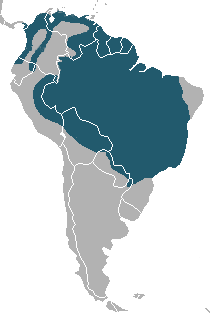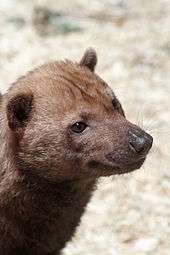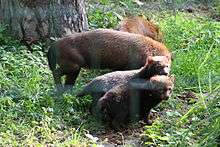Bush dog
| Bush dog[1] | |
|---|---|
.jpg) | |
| Bush dog at Prague Zoo | |
| Scientific classification | |
| Kingdom: | Animalia |
| Phylum: | Chordata |
| Class: | Mammalia |
| Order: | Carnivora |
| Family: | Canidae |
| Genus: | Speothos |
| Species: | S. venaticus |
| Binomial name | |
| Speothos venaticus (Lund, 1842) | |
| Subspecies | |
| |
 | |
| Bush dog range | |
The bush dog (Speothos venaticus) is a canid found in Central and South America.[1][2] In spite of its extensive range, it is very rare in most areas except in Suriname, Guyana, and Peru;[2][3] it was first identified by Peter Wilhelm Lund from fossils in Brazilian caves and was believed to be extinct.[3] The bush dog is the only living species in the genus Speothos,[1] and genetic evidence suggests that its closest living relative is the maned wolf of central South America[4] or the African wild dog.[5] The species is listed as Near Threatened by the IUCN.
In Brazil it is called cachorro-vinagre ("vinegar dog") or cachorro-do-mato ("bush dog"). In Spanish-speaking countries it is called perro vinagre ("vinegar dog"), zorro vinagre ("vinegar fox"), perro de agua ("water dog"), or perro de monte ("forest dog").
Description
Adult bush dogs have soft long brownish-tan fur, with a lighter reddish tinge on the head, neck and back and a bushy tail, while the underside is dark, sometimes with a lighter throat patch. Younger individuals, however, have black fur over their entire bodies.[3] Adults typically have a head-body length of 57–75 cm (22–30 in), with a 12.5–15 cm (5–6 in) tail. They have a shoulder height of 20–30 cm (8–12 in) and weigh 5–8 kg (11–18 lb).[6] They have short legs relative to their body, as well as a short snout and relatively small ears.[3]
The teeth are adapted for its carnivorous habits. Uniquely for an American canid, the dental formula is
| Dentition |
|---|
| 3.1.4.1 |
| 3.1.4.2 |
for a total of 38 teeth.[3] The bush dog is one of three canid species (the other two being the dhole and the African wild dog) with trenchant heel dentition, having a single cusp on the talonid of the lower carnassial tooth that increases the cutting blade length.[3] Females have four pairs of teats, and both sexes have large scent glands either side of the anus.[3] Bush dogs have partially webbed toes, which allow them to swim more efficiently.[7]
Distribution and habitat


Bush dogs are found from Costa Rica[8] in Central America, through much of South America east of the Andes, as far south as central Bolivia, Paraguay, and southern Brazil. They primarily inhabit lowland forests up to 1,900 metres (6,200 ft) elevation,[3] wet savannas, and other habitats near rivers, but may also be found in drier cerrado and open pasture.[2] The historic range of this species may have extended as far north as Costa Rica where the species may still survive in suitable habitat.[2][9][10]
There are three recognised subspecies:[1][3]
- Speothos venaticus venaticus - southern Colombia and Venezuela, the Guyanas, most of Brazil, eastern Ecuador and Peru, Bolivia, northern Paraguay
- Speothos venaticus panamensis - Panama, northern Colombia and Venezuela, western Ecuador
- Speothos venaticus wingei - southern Brazil and Paraguay, extreme north-eastern Argentina
Behavior
Bush dogs are carnivores and hunt during the day. Their typical prey are pacas, agouti, and capybaras, all large rodents. Although they can hunt alone, bush dogs are usually found in small packs. The dogs can bring down much larger prey, including peccaries and rheas, and a pack of six dogs has even been reported hunting a 250 kg (550 lb) tapir. When hunting paca, part of the pack chases it on land, and part wait for it in the water, where it often retreats.[3]
Bush dogs appear to be the most gregarious South American canid species. They use hollow logs and cavities such as armadillo burrows for shelter. Packs consist of a single mated pair and their immediate kin, and have a home range of 3.8 to 10 square kilometres (1.5 to 3.9 sq mi).[3] Only the adult pair breed, while the other members of the pack are subordinate, and help with rearing and guarding any pups.[11] Pack-mates keep in contact with frequent whines, perhaps because visibility is poor in the undergrowth where they typically hunt.[12] While eating large prey, parents position themselves at either ends of the animal, making it easier for the pups to disembowel it.[3]
Reproduction

Bush dogs mate throughout the year; oestrus lasts up to twelve days, and occurs every 15 to 44 days.[13] Like many other canids, bush dog mating includes a copulatory tie, during which the animals are locked together.[13] Urine-marking plays a significant role in their pre-copulatory behavior.[14][15]
Gestation lasts from 65 to 83 days, and normally results in the birth of a litter of three to six pups, although larger litters of up to ten have been reported.[3] The young are born blind and helpless, and initially weigh 125 to 190 grams (4.4 to 6.7 oz). The eyes open after fourteen to nineteen days, and the pups first emerge from the nativity den shortly thereafter.[3] The young are weaned at around four weeks, and reach sexual maturity at one year.[16] They live for up to ten years in captivity.[3]
References
- 1 2 3 4 Wozencraft, W.C. (2005). "Order Carnivora". In Wilson, D.E.; Reeder, D.M. Mammal Species of the World: A Taxonomic and Geographic Reference (3rd ed.). Johns Hopkins University Press. ISBN 978-0-8018-8221-0. OCLC 62265494.
- 1 2 3 4 5 DeMatteo, K.; Michalski , F. & Leite-Pitman, M.R.P. (2011). "Speothos venaticus". The IUCN Red List of Threatened Species. IUCN. 2011: e.T20468A9203243. doi:10.2305/IUCN.UK.2011-2.RLTS.T20468A9203243.en. Retrieved 25 December 2017. Database entry includes justification for why this species is near threatened
- 1 2 3 4 5 6 7 8 9 10 11 12 13 14 15 de Mello Beiseigel, B. & Zuercher, G.L. (2005). "Speotheos venaticus". Mammalian Species: Number 783: pp. 1–6. doi:10.1644/783.1.
- ↑ Wayne, R.K.; et al. (1997). "Molecular systematics of the Canidae". Systematic Biology. 46 (4): 622–653. doi:10.1093/sysbio/46.4.622. PMID 11975336.
- ↑ Nyakatura, K.; et al. (2012). "Updating the evolutionary history of Carnivora (Mammalia): a new species-level supertree complete with divergence time estimates". BMC Biology. 10 (12). doi:10.1186/1741-7007-10-12.
- ↑ "Speothos venaticus | ARKive". ARKive. Retrieved 15 December 2016.
- ↑ David Attenborough (November 20, 2002). The Life of Mammals, Episode 5: Meat Eaters (16:9 Stereo)
|format=requires|url=(help) (Documentary). United Kingdom: BBC/Discovery Channel. Event occurs at 17:10 min.|access-date=requires|url=(help) - ↑ Alvarado, Laura. New Mammal Species Found in Costa Rica. Available at: https://news.co.cr/new-mammal-species-found-in-costa-rica/68595/
- ↑ Rosa, C. L., de la and Nocke, C. C. 2000. A Guide to the Carnivores of Central America: Natural History, Ecology, and Conservation. University of Texas Press, Austin, TX, USA.
- ↑ Sillero-Zubiri, Claudio; Hoffman, Michael; and MacDonald David W. Canids: Foxes, Wolves, Jackals, and Dogs: Status Survey and Conservation Action Plan. Gland, Switzerland and Cambridge, UK: IUCN; 2004. p77.
- ↑ Macdonald, D.W. (1996). "Social behaviour of captive bush dogs (Speothos venaticus)". Journal of Zoology. 239 (4): 525–543. doi:10.1111/j.1469-7998.1996.tb05941.x.
- ↑ Macdonald, D. (1984). The Encyclopedia of Mammals. New York: Facts on File. p. 31. ISBN 0-87196-871-1.
- 1 2 Porton, I.J.; et al. (1987). "Aseasonality of bush dog reproduction and the influence of social factors in the estrous cycle" (PDF). Journal of Mammalogy. 68 (4): 867–871. doi:10.2307/1381569. JSTOR 1381569.
- ↑ Porton, Ingrid. "Bush dog urine-marking: its role in pair formation and maintenance." Animal behaviour 31.4 (1983): 1061-1069.
- ↑ Kleiman, Devra G. "Social behavior of the maned wolf (Chrysocyon brachyurus) and bush dog (Speothos venaticus): a study in contrast." Journal of Mammalogy 53.4 (1972): 791-806.
- ↑ Bekoff, M.; et al. (1981). "Life-history patterns and sociality in canids: body size, reproduction, and behavior". Oecologia. 50 (3): 386–390. doi:10.1007/BF00344981.
Bibliography
- Nicole Duplaix and Noel Simon, World Guide to Mammals. Mandarin Publishers Ltd. (1976).
- Flower WH. 1880. On the bush-dog (Icticyon venaticus Lund). Proceedings of the Zoological Society of London 1880: 70–76.
External links
| Wikispecies has information related to Speothos |
| Wikimedia Commons has media related to Speothos venaticus. |
